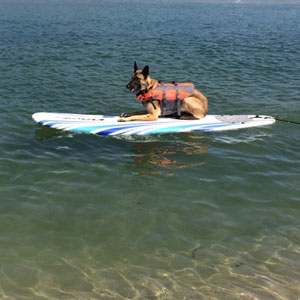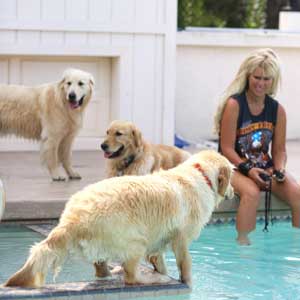About Hot Dog on a Leash
Hot Dog on a Leash has Trainers/Behavior Specialists with over 25 years of experience with all types of dogs, big or small.
Our trainers are bilingual too!
When a dog learns to make his own decisions based upon his experiences, he becomes able to be reliable off the leash and is more capable of problem solving in unusual or difficult situations. You may notice that this is not so different from your desired results when teaching children. Dog training is similar to raising children but more difficult for people to understand because we must communicate with the dog from a canine point of view. This requires that we have an understanding of how dogs think and perceive their world. We understand that this is an integral part of our job, to teach the client how to best communicate clearly with their dog.
The Myths about training collars: Many people are confused about the use of training collars. There are many collars and leads on the marker that range from gentle leaders, training harnesses, flat collars, partial slip collars, martingales, slip collars, pinch collars, and shock collars. Because of the variety of training methods available, there is no wonder that people are confused.
The best way to get to the truth of the matter is to look at which collar is used throughout the world in competitions. If you care to observe the facts in this matter, you will quickly notice that nearly all of the dogs you see in competition will be wearing some form of slip collar (choke chain). When used properly, this collar is not used to choke the dog. The slip collar is used simply to give to dog a correction with a quick pop and release, and should never be used to actually choke a dog. Novice trainers who have little practical experience with dogs, or who have learned to train from a pet store chain may not know how to use these collars because their use is prevented due to corporate policy.
Professional trainers know that it is the person using the collar, not the collar itself that can cause damage to the dog. For that matter a dog whose head is jerked in the wrong direction using gentle leader can cause neck damage. Again, this is misuse of a piece of equipment. If you speak to a trainer who tells you that training collars are abusive, you should ask them how many titles or certifications they have achieved. We have had hundreds of people attempt to use corporate methods, treats, and no training collars to train their dogs, just to have them come to us afterwards with dogs that are 10-20 percent trained and have to pay for training all over again.
As a consumer, you should know that there are three main training systems available for you. At the lowest levels of training you will find your “click and treat” and “gentle leader of harness” methods. This philosophy is a liberal style that believes that all corrections are bad and you should simply reward good behavior with food and ignore bad behavior. This basic flaw in the style of training is that it does not work for dogs that are not hungry (unless you withhold food), or for dogs with dominant personalities. Since the dog is not being taught ritual behaviors that keeps the owner into responding to its every desire. Although there are many methods that involve treat rewards for dogs, the lack of correction is akin to raising a child without correction. The problem is that some behaviors themselves are rewarding.
The Middle Ground (Centrist Position): The middle ground is what we believe in at Hot Dog On A Leash. Our methods are a blend of positive motivation and mild correction. It is very important to dogs in their own canine psychology that they know where their boundaries of behavior lie. These are established through training which allows you to use “ritual Behaviors” to keep the dog in check. The dog should understand that you are the “alpha” (dominant) in the pack.
We will use whatever motivates your dog to our advantage. This means that we will use food, toy, tactile, and verbal praise. We will eventually wean the dog onto a praise-based system, but scientists have proven that the best reward system is intermittent. This allows the dog to always expect that he could receive a reward at any given time. This has the effect of keeping his performance level high even in the temporary absence of food or toy reward.
If you consider how you would train your child, (treats and no correction vs. compulsion) most people would say neither. There must be some middle ground that is fair to the subject of the training, non-spoiling, but yet non-abusive. There is a mixture between praise, treats, and correction. Our goal is to be able to teach every owner a practical way to train their dog and use it in their everyday life.
The Team
Heather Oakes
Owner
Behavior Specialist / Trainer / SAR Instructor / Surfing Instructor
Dustin Bratton
Marketing and Advertising Manager
Ingrid
Doggie Daycare Supervisor













